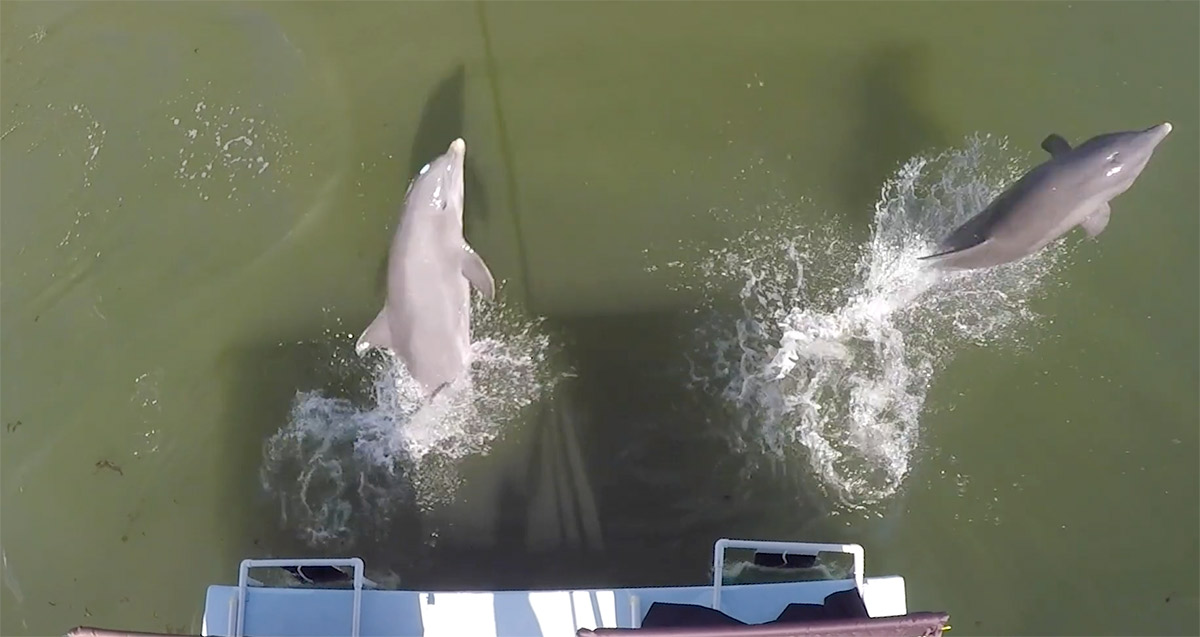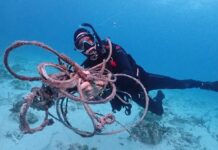By Sarah Mandile
Two bottlenose dolphins glide underwater as they approach two buttons located on the edge of their enclosure. After simultaneously pushing them, a celebratory buzzer sounds. Both dolphins joyfully leap into the air. Dolphin trainers at the edge of the lagoon clap their hands and cheer before stopping to record the events on clipboards.
This is part of one of many research projects that Kelly Jaakkola, director of research at the Dolphin Research Center, has organized. Exploring the communication and cooperation skills of dolphins, this study tests their ability to coordinate the pressing of two buttons despite approaching them from varying distances.
“We wanted to see if dolphins could actively cooperate,” said Jaakkola. “Can they understand a situation where they have to work together to accomplish a task? The game was that the dolphins had to swim across the lagoon and press the buttons simultaneously – specifically, within a one-second time window.”
The dolphin teams more than succeeded. With only a third of a second in between their button presses on average, they displayed the ability to coordinate and synchronize their behaviors. According to Jaakkola, this concept, known as “behavioral synchronization”, is shown by bottlenose dolphins in the wild when they coordinate activities such as swimming or feeding.
Jaakkola has been organizing research projects like this one at the Dolphin Research Center since becoming director of research in 2002. She hails from Delaware and has studied cognition and psychology, with a focus on human children and chimps. However, she has always had a love for dolphins. “Since I was a kid I thought dolphins were way cool; I still think dolphins are way cool.”
Jaakkola discovered the DRC while she was in college and had the opportunity to participate in Dolphin Lab. She returned a few years later to assist another researcher, Peter Tyact, with a study on dolphin signature whistles.
Since then, Jaakkola has assisted the Dolphin Research Center with many studies, one of the most recent comparing the life spans of dolphins in the wild to dolphins in captivity. The last study on this subject had been done in 1995 when life expectancy for dolphins in captivity was still increasing and scientists were still learning how to care for dolphins properly. Jaakkola worked on this project on and off since 2016, carefully collecting information and making sure to use analysis methods that would result in accurate comparisons.
“Survival rates and life expectancies are indicators of overall health and well-being,” said Jaakkola. “Critics of zoos and aquariums will frequently claim that dolphins in facilities don’t live as long as dolphins in the wild, in an attempt to influence public opinion and even proposed legislation.” Published in the Marine Mammal Science Journal, the study found that bottlenose dolphins living in captivity in the United States live just as long as, or even longer than, dolphins in the wild.
“It’s not enough to just give people information about conservation; the moment of connection is the start of marine conservation.”
— Mary Stella, Dolphin Research Center director of media and marketing
This is affirming news for the Dolphin Research Center which, since its founding in 1984, has been caring for marine animals. “We have a long history of providing homes for animals that need them,” said Mary Stella, director of media and marketing. Not only has the DRC been a home for rehabilitated animals, it also has been the site of many research projects that serve to improve understanding of dolphins and influence legislation. “Having these animals in human care,” said Stella, “allows us to learn about them in various ways that we never would otherwise.”
For those who have ever had doubts about the health and well-being of dolphins living in captivity, this study provides reassurance and brings into perspective the benefits of having marine animals in a location where they can be observed and interacted with. Not only does the presence of the dolphins at the DRC allow scientists to make new discoveries, it also provides the opportunity for visitors to learn and connect with dolphins. It’s these exchanges between humans and dolphins that can truly inspire the public to care about marine life. “It is not enough to just give people information about conservation,” said Stella. “The moment of connection is the start of marine conservation.”

























